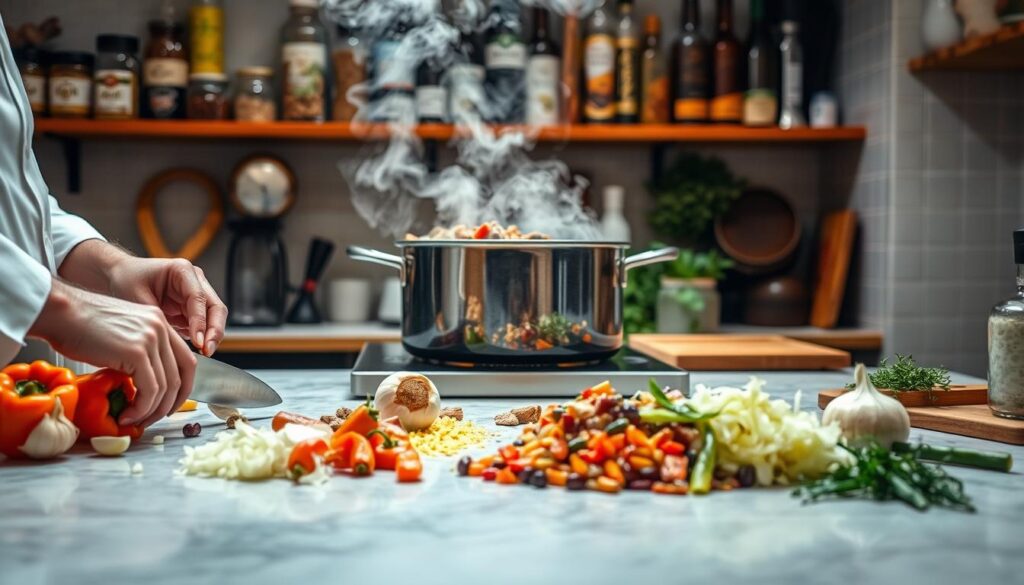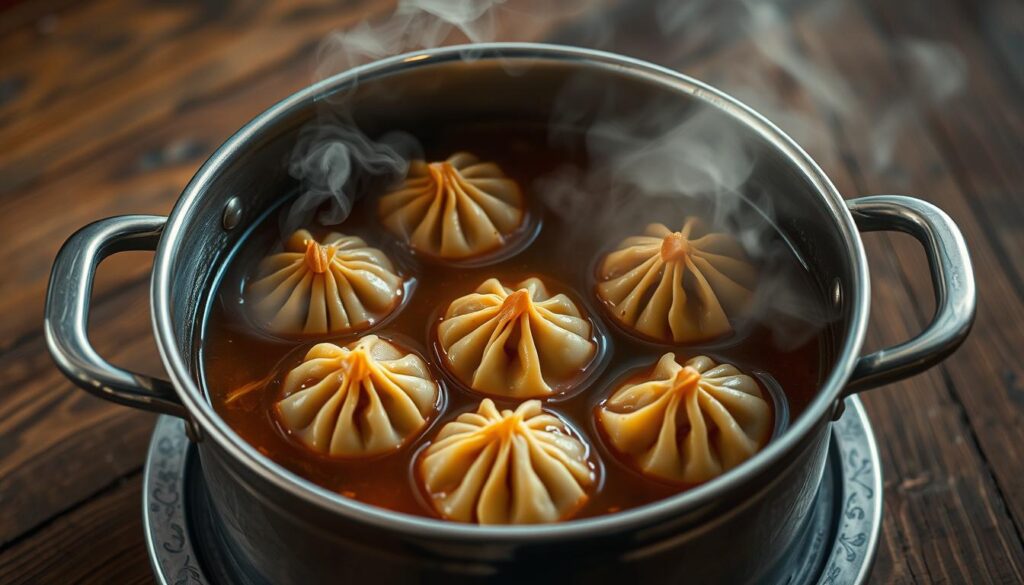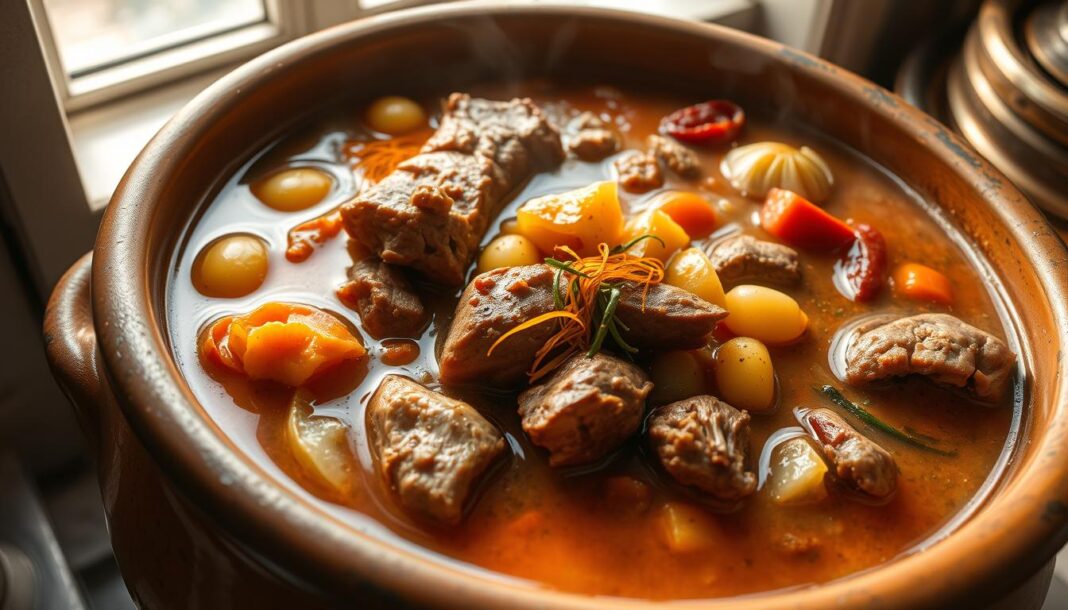We embark on a culinary journey to explore the rich heritage of olla podrida, a stew that has been a cornerstone of Spanish cuisine for centuries. This traditional dish, literally translated as “rotten pot,” is a flavorful representation of Spain’s gastronomic culture, made with a variety of meats and vegetables.
The name “olla podrida” may raise eyebrows, but it likely originates from “poderida,” meaning “powerful pot,” reflecting the dish’s robust flavors and hearty ingredients, including chickpeas, assorted meats, and an array of vegetables like carrots and cabbage.
Since at least the 17th century, olla podrida has been referenced in literature, showcasing its significance in Spanish culture. This article will guide you through understanding the cultural importance and practical preparation of this remarkable dish, highlighting its position in the pantheon of Spanish cuisine.
Key Takeaways
- Understanding the etymology and cultural significance of olla podrida.
- Exploring the traditional components and ingredients of the stew.
- Learning about the historical references to olla podrida in literature.
- Discovering how olla podrida represents Spanish culinary traditions.
- Gaining insights into the preparation and cooking techniques of olla podrida.
The Rich Heritage of Olla Podrida
With roots dating back centuries, olla podrida has evolved into a symbol of Spanish gastronomy. This traditional stew has a rich history that reflects the country’s agricultural practices, social conditions, and culinary techniques.
Origins and Etymology
Olla podrida’s origins are complex, with its name translating to “rotten pot.” However, this doesn’t reflect the dish’s actual quality. From the XIX century, different stew recipes were collected, adapting to each territory’s productive and social conditions. The stews were presented in two ways: “in overturns,” separating ingredients like soup, legumes, vegetables, and meat, or all mixed.
Historical Significance in Spanish Cuisine
Olla podrida became a cornerstone of Spanish cuisine, representing the country’s approach to hearty, communal eating. We examine how it evolved from a wealthy household’s meal to a dish accessible across social classes. Its influence on other Spanish stews and regional variations is significant. We analyze how olla podrida reflects Spain’s agricultural history and traditional ingredients. Despite changing dietary preferences, olla podrida has maintained its cultural significance in modern Spain.
- Olla podrida represents Spain’s culinary traditions and communal eating practices.
- The dish evolved to become more accessible across different social classes.
- It influenced various Spanish stews and regional dishes.
- Olla podrida reflects Spain’s agricultural history and traditional ingredients.
- The dish remains culturally significant in contemporary Spanish cuisine.
Understanding the Traditional Olla Podrida
As we explore olla podrida, it becomes clear that this traditional Spanish stew has many regional interpretations. This diversity is a testament to the dish’s adaptability and its deep roots in Spanish culinary culture.
Regional Variations Across Spain
Olla podrida is not a monolithic dish; it varies significantly from one region to another. Different regions in Spain incorporate local ingredients and cooking techniques, resulting in a wide array of variations. For instance, some regions may emphasize certain types of meat or use specific seasonings that are locally sourced.
Key Ingredients and Their Significance
The traditional olla podrida recipe includes a variety of ingredients, each contributing to its rich flavor profile. Key components include legumes like red beans, various meats such as pork (ears, trotter, ribs), beef, spicy sausages, and black puddings, along with aromatic vegetables like onions and garlic, and seasonings including sweet paprika and bay leaves. For 6 people, the ingredients are: 500g of red beans, 1 pig’s ear, 1/2 a pig’s trotter, 200g of pork ribs, 200g of dried beef, 3 spicy sausages, 3 black puddings from Burgos, 200g of bacon, 1 medium onion, 1 head of garlic, 1 tsp of sweet paprika, 1 tbsp of flour, 1 bay leaf, and 3 tbsp of olive oil. The combination of these ingredients represents a philosophy of using available resources efficiently.
Essential Preparation Techniques
Mastering olla podrida requires attention to detail in its preparation techniques. The process involves several crucial steps that ensure the dish’s rich flavor and tender texture.
Bean Soaking and Meat Marination
Proper bean soaking is essential to reduce cooking time and enhance digestibility. We recommend soaking beans overnight in cold water. Meanwhile, meat marination is critical for developing the deep flavors characteristic of olla podrida. The marination process involves coating the meat, typically pork, in a mixture that includes Spanish paprika, garlic, and olive oil.
Creating the Perfect Adobo
Creating the perfect adobo is a pivotal step in preparing olla podrida. To make the adobo, combine ¼ cup Spanish paprika, 3 Tablespoons dry oregano, 2-3 cloves minced garlic, 5-6 Tablespoons extra virgin olive oil, 4-5 Tablespoons vinegar, and 3-4 Tablespoons water in a non-reactive container. Add the pork, ensuring it’s well-coated, cover, and refrigerate overnight.
| Ingredient | Quantity | Purpose |
|---|---|---|
| Spanish Paprika | ¼ cup | Flavor and Color |
| Dry Oregano | 3 Tablespoons | Herbal Flavor |
| Garlic (minced) | 2-3 cloves | Aroma and Flavor |
| Extra Virgin Olive Oil | 5-6 Tablespoons | Moisture and Flavor |
| Vinegar | 4-5 Tablespoons | Acidity and Preservation |
| Water | 3-4 Tablespoons | Consistency |

Step-by-Step Cooking Process
With the ingredients prepared, we now dive into the step-by-step cooking process that makes Olla Podrida a culinary masterpiece. This traditional Spanish stew requires patience and attention to detail, but the end result is well worth the effort.
Cooking the Meats and Beans
Cooking the meats and beans is a crucial step in making Olla Podrida. We start by browning the meats to lock in the flavors, then add the soaked beans and other ingredients to create a rich broth. The key is to cook the mixture slowly, allowing the flavors to meld together. This slow cooking process is essential for developing the characteristic depth of flavor in Olla Podrida.
Preparing the Relleno Dumplings
To prepare the relleno dumplings, we combine beaten eggs, breadcrumbs, minced parsley, and garlic in a bowl. The mixture is then fried in hot olive oil, forming little fluffy dumpling-like balls. These dumplings are added to the stew a few minutes before serving, absorbing the rich broth flavors and adding a contrasting texture. 
Serving and Enjoying Your Authentic Olla Podrida
Let’s bring our olla podrida to the table, following traditional Spanish serving methods. About 10 minutes before serving, return the meat to the pot along with the morcilla and rellenos, and simmer until the meat is heated through.
Serve the beans and relleno dumplings in bowls, accompanied by the meat on a separate platter, and don’t forget a glass of Spanish wine. You can serve it together or as two courses, separating the meat from the beans. Some people like to add a pinch of sweet or spicy paprika for extra flavor.


